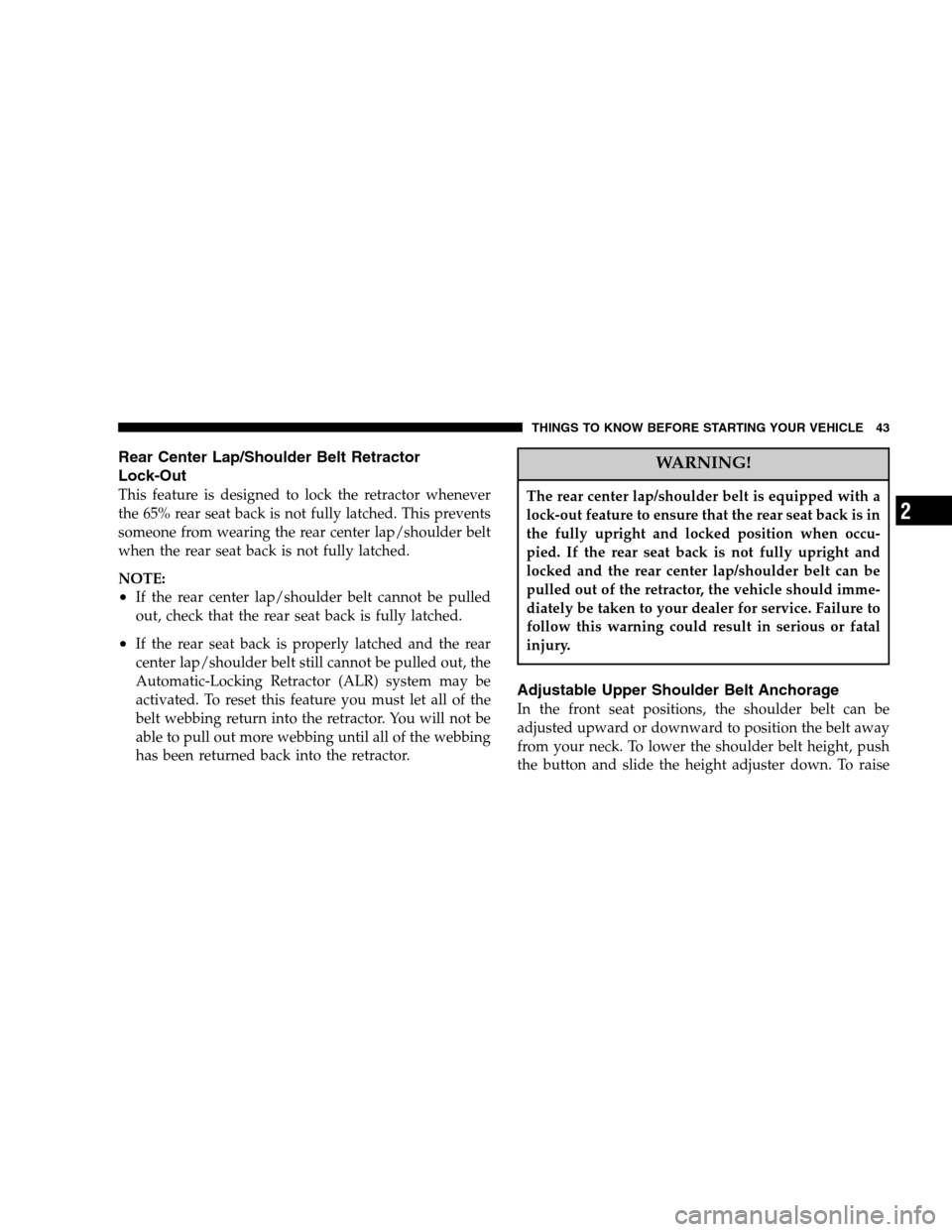Page 31 of 417
WINDOWS
Power Front Windows
The power window switches are located on the center
floor console. The top left switch controls the left front
window and the top right switch controls the right front
window. The lower left switch controls the left rear
passenger window, and the lower right switch controls
the right rear passenger window. The switches will
continue to function for up to 10 minutes after the
ignition key has been removed, or until a door is opened.
The window lock switch located next to the window
switches allows you to disable the rear passenger win-
dow switches that are located on the back of the center
floor console.
Power Window Switches
THINGS TO KNOW BEFORE STARTING YOUR VEHICLE 31
2
Page 33 of 417
windows down, or the sunroof (if equipped) in certain
open or partially open positions. This is a normal occur-
rence and can be minimized. If the buffeting occurs with
the sunroof open, adjust the sunroof opening to minimize
the buffeting.
REAR SWING GATE
The swing gate can be unlocked using the remote keyless
entry, or by activating the power door lock switches
located on the front doors.
WARNING!
To avoid injury stand back when opening. Glass will
automatically rise.
To open the swing gate, pull the gate handle to its first
detent to open just the flip-up window. Pull the handle to
its second detent (all the way) to open both the flip-up
window and swing gate.
Swing Gate Release Handle
THINGS TO KNOW BEFORE STARTING YOUR VEHICLE 33
2
Page 36 of 417

WARNING!
Driving with the flip-up window open can allow
poisonous exhaust gases into your vehicle. You and
your passengers could be injured by these fumes.
Keep the flip-up window closed when you are
operating the vehicle.
NOTE: The rear swing gate will lock while the rear
wiper is operating. The gate will stay locked until the
wiper is turned off and the gate is unlocked (by key,
lock switch, or key fob).
NOTE:The swing gate will lock automatically when the
vehicle begins moving.
OCCUPANT RESTRAINTS
Some of the most important safety features in your
vehicle are the restraint systems. These include the front
and rear seat belts for the driver and all passengers, front
airbags for both the driver and front passenger and, if
equipped, window bags for the driver and passengers
seated next to a window. If you will be carrying children
too small for adult-size belts, your seat belts also can be
used to hold infant and child restraint systems.
NOTE:The front airbags have a multi stage inflator
design. This allows the airbag to have different rates of
inflation that are based on collision severity.
Please pay close attention to the information in this
section. It tells you how to use your restraint system
properly to keep you and your passengers as safe as
possible.
36 THINGS TO KNOW BEFORE STARTING YOUR VEHICLE
Page 38 of 417

The belt webbing retractor is designed to lock during
very sudden stops or collisions. This feature allows the
shoulder part of the belt to move freely with you under
normal conditions. But in a collision, the belt will lock
and reduce the risk of you striking the inside of the
vehicle or being thrown out.WARNING!
•Wearing a seat belt incorrectly is dangerous. Seat
belts are designed to go around the large bones of
your body. These are the strongest parts of your
body and can take the forces of a collision the
best. Wearing your belt in the wrong place could
make your injuries in a collision much worse. You
might suffer internal injuries, or you could even
slide out of part of the belt. Follow these instruc-
tions to wear your seat belt safely and to keep
your passengers safe, too.
•Two people should never be belted into a single
seat belt. People belted together can crash into one
another in an accident, hurting one another badly.
Never use a lap/shoulder belt or a lap belt for
more than one person, no matter what their size.
38 THINGS TO KNOW BEFORE STARTING YOUR VEHICLE
Page 43 of 417

Rear Center Lap/Shoulder Belt Retractor
Lock-Out
This feature is designed to lock the retractor whenever
the 65% rear seat back is not fully latched. This prevents
someone from wearing the rear center lap/shoulder belt
when the rear seat back is not fully latched.
NOTE:
•If the rear center lap/shoulder belt cannot be pulled
out, check that the rear seat back is fully latched.
•If the rear seat back is properly latched and the rear
center lap/shoulder belt still cannot be pulled out, the
Automatic-Locking Retractor (ALR) system may be
activated. To reset this feature you must let all of the
belt webbing return into the retractor. You will not be
able to pull out more webbing until all of the webbing
has been returned back into the retractor.
WARNING!
The rear center lap/shoulder belt is equipped with a
lock-out feature to ensure that the rear seat back is in
the fully upright and locked position when occu-
pied. If the rear seat back is not fully upright and
locked and the rear center lap/shoulder belt can be
pulled out of the retractor, the vehicle should imme-
diately be taken to your dealer for service. Failure to
follow this warning could result in serious or fatal
injury.
Adjustable Upper Shoulder Belt Anchorage
In the front seat positions, the shoulder belt can be
adjusted upward or downward to position the belt away
from your neck. To lower the shoulder belt height, push
the button and slide the height adjuster down. To raise
THINGS TO KNOW BEFORE STARTING YOUR VEHICLE 43
2
Page 44 of 417
the height of the shoulder belt, slide the height adjuster
up. Pull down on the height adjuster to make sure it is
locked in place.WARNING!
Position the shoulder belt height adjusters so that
the belt rests across the middle of your shoulder.
Failure to adjust the safety belt properly could
reduce the effectiveness of the seat belt and increase
the risk of injury in a collision.
As a guide, if you are shorter than average, you will
prefer a lower position, and if you are taller than average,
you’ll prefer a higher position. When you release the
anchorage, try to move it up or down to make sure that
it is locked in position.
Automatic Locking Mode — If Equipped
In this mode, the shoulder belt is automatically pre-
locked. The belt will still retract to remove any slack in
the shoulder belt.Adjusting Upper Shoulder Belt
44 THINGS TO KNOW BEFORE STARTING YOUR VEHICLE
Page 45 of 417

When To Use The Automatic Locking Mode
Anytime a child safety seat is installed in a passenger
front or outboard rear seating position (if equipped).
Children 12 years old and under should be properly
restrained in the rear seat whenever possible.
How To Use The Automatic Locking Mode
1. Buckle the combination lap and shoulder belt.
2. Grasp the shoulder portion and pull downward until
the entire belt is extracted.
3. Allow the belt to retract. As the belt retracts, you will
hear a clicking sound. This indicates the safety belt is
now in the automatic locking mode.
How to Disengage The Automatic Locking Mode
Disconnect the combination lap/shoulder belt and allow
it to retract completely to disengage the automatic lock-
ing mode and activate the vehicle sensitive (emergency)
locking mode.
Energy Management Feature
This vehicle has a safety belt system with an energy
management feature at the driver and front passenger
seating positions to help further reduce the risk of injury
in the event of a head-on collision.
This safety belt system has a retractor assembly that is
designed to pay out webbing in a controlled manner. This
feature is designed to help reduce the belt force acting on
the occupant’s chest.
THINGS TO KNOW BEFORE STARTING YOUR VEHICLE 45
2
Page 46 of 417

WARNING!
•After a vehicle collision, the driver and front
passenger outboard seat belt system must be
checked by a qualified technician to verify that
the “automatic locking retractor” feature for child
seats is still functioning properly. In addition, all
seat belts should be checked for proper function.
•The belt and retractor assembly must be replaced
if the seat belt assembly “automatic locking re-
tractor” feature or any other seat belt function is
not working properly when checked according to
the procedures in the Service Manual.
•Failure to replace the belt and retractor assembly
could increase the risk of injury in collisions.
Seat Belt Pretensioners
The driver and front passenger seat belts are equipped
with a pretensioning device that is designed to remove
any slack from the seat belt systems in the event of a
collision. This device improves the performance of the
seat belt by assuring that the belt is tight around the
occupant early in a collision. Pretensioners work for all
size occupants, including those in child restraints.
NOTE:These devices are not a substitute for proper seat
belt placement by the occupant. The seat belt must still be
worn snugly and positioned properly.
The pretensioners are triggered by the front Airbag
Control Module. Like the front airbags, the pretensioners
are a single use item. After a collision that is severe
enough to deploy the airbags and pretensioners, they
must be replaced.
46 THINGS TO KNOW BEFORE STARTING YOUR VEHICLE